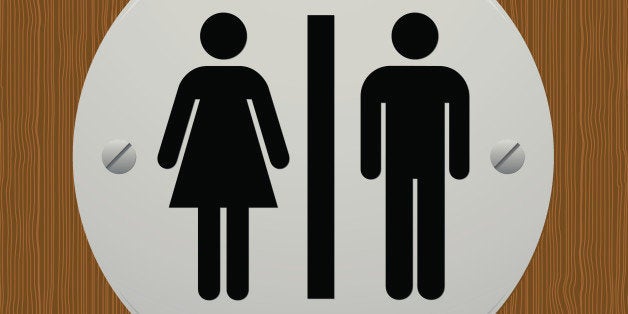
You may have heard about how voters in Houston recently rejected the so-called "bathroom ordinance," a broad equal rights ordinance which would have prohibited discrimination based on race, sex, sexual orientation and gender identity, among a host of other attributes, and in fact made no explicit mention of public restrooms.
Despite this complete lack of bathroom language, opponents of the law dubbed it the "bathroom ordinance" and ran advertisements depicting a man preying on a young girl in a women's restroom. The opponents did such a good job of twisting and smearing the law that the voters in Houston rejected it by a wide margin.
What does it say that trans-phobic people are focusing on bathrooms, and hiding under the guise of protecting women's safety, in order to score their victories against trans rights? Well, they're probably using this strategy because--at least in this case--it's working.
Voters in a liberal city rejected an equal rights protection law, because trans-phobic bigots managed to convince an awful lot of people that there is danger in allowing someone with the "wrong" genitals into a restroom.
In order set this matter straight, and convince people that this "danger" is a complete farce, we first have to answer this question: What's the purpose of separating men's and women's bathrooms in the first place?
It can't be to prevent men from seeing women's genitals and prevent women from seeing men's genitals. Nobody is looking at other people's private parts when they use a public restroom. It can't be to protect women from male predators, because let's be real--if a predator is after you to hurt you, he isn't going to be stopped by an un-locked door with an amorphous figure in a triangle dress stamped on the front of it. The only protection a woman might get by hiding in a women's restroom is the possible presence of other women, who could serve as witnesses and might deter a predator. This protection could be afforded by any quiet, well-lit public location.
So when we rule out the two above reasons--the only two explanations that might make sense, but fall apart upon close examination--we are left with one alternative: The sole purpose of separating men's and women's bathrooms is to preserve a sense of social order. It's similar to the reason we separate our sock drawer from our underwear drawer. Each thing has its assigned place, and that makes us feel better.
So if the only purpose of having sex-segregated bathrooms is to preserve social order, the best way to have those facilities continue to serve that purpose is to let transgender people use the bathroom that corresponds to their gender. A trans man who has the complete physical appearance of a man is not going to ring any alarm bells when he walks into a men's restroom. The social order will not be disrupted. If he walks into a women's restroom, however, the women in the restroom are going to wonder why he's in there, and perhaps feel uncomfortable.
Our desperate need to preserve social order by separating bathrooms, though, is going to have to be done away with soon. The Houston Chronicle points out that trans women often have a harder time using their preferred restroom than trans men, because trans women's features, such as their height and build, more easily give away the fact that their gender identity doesn't match their sex. Their bodies disrupt the male-female binary that cis people take such comfort in. Trans women are more likely to experience harassment and violence when using a women's restroom.
We also haven't talked about gender-nonconforming people, who feel as though they don't fit into the category of "man" or "woman." Which restroom are they supposed to use in order to protect our precious social order?
I recently went to a nightclub where the bathrooms were not sex-segregated. There was just one multi-stalled bathroom that did not even have a door on it--only an open entry-way. Men and women formed a line starting at this entryway and waited for the next stall to open. Nobody looked uncomfortable.
Many establishments have already figured out that having integrated restrooms is beneficial for everyone. I see more and more "family bathrooms," which are good for parents who have to take their young children of the opposite gender to the bathroom with them. Whenever there is a family bathroom option, I almost always use it, because the line is almost always shorter.
And I can't even tell you how many times one of my girlfriends or I have gone into the men's bathroom when the women's had a huge line and the men's had none. And guess what happened? Nothing.
As human beings, we like to categorize everything. It makes us feel comfortable. But the reality is that when you start putting your socks and your underwear into the same drawer, the dresser doesn't fall apart. You can still find what you're looking for. Everything is fine. And pretty soon you'll forget that you ever felt like you needed to separate them.
Time and time again we have rearranged the make-up of our physical world, when the people in power have finally realized that the current arrangement is oppressive to one or more groups without power. We integrated our schools and (hey!) our bathrooms between races. We have changed our sidewalks and our buildings to allow access to people with disabilities. We need to now redesign the space we live in so that it no longer privileges cis-gendered bodies. Because preserving our petty, socially constructed idea of comfort is not worth compromising other people's safety, and humanity.
We are all human. It's time to start acting like it.
